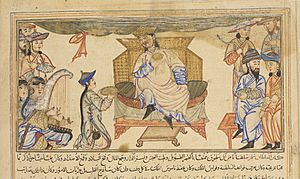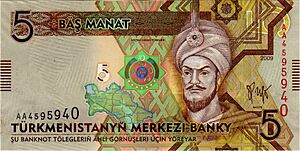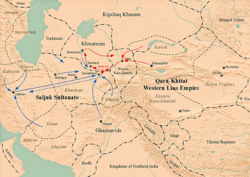Ahmad Sanjar facts for kids
Quick facts for kids Ahmad Sanjar |
|
|---|---|

Ahmad Senjer seated on his throne, in a 1307 Ilkhanid miniature.
|
|
| Sultan of the Great Seljuq Empire | |
| Reign | 18 April 1118 – 8 May 1157 |
| Predecessor | Muhammad I |
| Co-sultan | Mahmud II (1118–1131) Dawud (1131–1132) Tughril II (1132–1134) Mas'ud (1134–1152) Malik-Shah III (1152–1153) Muhammad II (1153–1157) |
| Malik of Khorasan | |
| Reign | 1097–1118 |
| Predecessor | Muhammad I Tapar |
| Successor | Kara-Khitan conquest |
| Born | 6 November 1086 Sinjar |
| Died | 8 May 1157 (aged 70) Merv |
| Consort |
|
| Issue |
|
| Dynasty | Seljuq |
| Father | Malik-Shah I |
| Mother | Taj Safariyya Khatun |
| Religion | Sunni Islam |
Ahmad Sanjar (Persian: احمد سنجر) was a powerful ruler of the Seljuq Empire. He was born on November 6, 1086, and died on May 8, 1157. Sanjar first ruled the region of Khorasan from 1097. In 1118, he became the Sultan of the entire Seljuq Empire. He led the empire until his death.
Contents
Early Life of Ahmad Sanjar
Sanjar was born in 1086 in Sinjar, a town in northwestern Iraq. His name, Sanjar, is a Turkic word. It means "he who pierces" or "he who thrusts." Sanjar was one of the sons of Malik-Shah I, a powerful Seljuq Sultan.
After his father's death, Sanjar fought against his brothers and a nephew. These were Mahmud I, Barkiyaruq, Malik Shah II, and Muhammad I. In 1096, his brother Muhammad I gave him the province of Khorasan to govern. Over the next few years, Sanjar became the ruler of most of Iran. His capital city was Nishapur.
Sanjar as Governor of Khorasan
As governor, Sanjar faced many challenges. Several local rulers tried to rebel against him. This continued the split of the Great Seljuq Empire. In 1102, Sanjar stopped an invasion from Kashgaria. He defeated their leader, Jibrail Arslan Khan, near Termez.
In 1107, Sanjar attacked the lands of the Ghurid ruler Izz al-Din Husayn. He captured Husayn but later released him. Husayn then agreed to pay tribute to Sanjar.
Dealing with the Nizari Ismailis
Sanjar also worked to remove the Nizari Ismailis from Persia. He successfully drove them out of many of their strongholds. These included places like Quhistan and Tabas. There is a story that Sanjar was on his way to their main stronghold, Alamut. One morning, he woke up to find a dagger next to him. A note from Hassan-i Sabbah, the Ismaili leader, was pinned by the dagger. The note said Hassan wanted peace. Sanjar was surprised and sent messengers to Hassan. They both agreed to leave each other alone.
In 1117, Sanjar marched against the Ghaznavid Sultan Arslan-Shah. He defeated Arslan-Shah at the Battle of Ghazni. Sanjar then placed Arslan-Shah's brother, Bahram-Shah, on the throne. Bahram-Shah ruled as a vassal, meaning he was under Seljuq control.
Sanjar Becomes Sultan
In 1105, Sultan Barkiyaruq died. He chose his younger son, Muizzeddin Malik-Shah, as his heir. This son became Malik-Shah II. However, the real power was held by his uncle, Muhammad Tapar. Muhammad Tapar soon removed his nephew from the throne. He then became the Sultan himself.
When Muhammad Tapar died in 1118, his son Mahmud II became the new Sultan. Around this time, the Emir of Yazd, Garshasp II, faced problems. People spread rumors about him at Mahmud's court. Mahmud sent soldiers to Yazd, arrested Garshasp, and put him in jail. Yazd was then given to a royal official.
However, Garshasp escaped and returned to Yazd. He asked Ahmad Sanjar for help. Garshasp's wife was Sanjar's sister, so they were family. Garshasp encouraged Sanjar to invade Mahmud's lands in Central Iran. He also gave Sanjar important information about how to march there and fight Mahmud.
Victory and Expansion
Sanjar agreed to help and marched west with his army in 1119. He and "five kings" defeated Mahmud at Saveh. The kings who helped Sanjar included Garshasp, the Emir of Sistan, and the Khwarazmshah. Nizari forces also joined Sanjar's army. After winning, Sanjar gave Garshasp his lands back.
Sanjar then marched all the way to Baghdad. There, he made an agreement with Mahmud. Mahmud had to marry one of Sanjar's daughters. He also had to give up important territories in northern Persia.
The Battle of Qatwan
In 1141, Sanjar faced a new threat from the Kara Khitan. He marched with Garshasp II to fight them near Samarkand. This battle was called the Battle of Qatwan. Sanjar suffered a terrible defeat. Garshasp was killed in the battle. Sanjar escaped with only fifteen of his best horsemen. He lost all Seljuq land east of the Syr Darya river.
Capture and Escape
Sanjar's rule and the Seljuq Empire began to fall apart after another unexpected defeat. This time, they were defeated by their own tribe, the Ghuzz Turks, in 1153. Sanjar was captured during the battle. He was held prisoner until 1156. This caused chaos in the empire. The victorious Turkmens took advantage of the situation. Their groups overran Khorasan, causing huge damage to the province.
Sanjar finally escaped from captivity in late 1156. But he died soon after in Merv (which is in modern-day Turkmenistan) in 1157. After his death, different Turkic rulers and tribal forces fought for control of Khorasan. After many conflicts, the province was finally taken by the Ghurids in 1192. Later, the Khwarazmians conquered it in the early 1200s.
Death and Legacy
Sanjar died in 1157 and was buried in Merv. His tomb was destroyed by the Mongols in 1221. This happened during their invasion of the Khwarezmian Empire.
Sanjar's death marked the end of the Seljuq dynasty as a major empire. After him, they only controlled parts of Iraq and Azerbaijan. Sanjar is seen as one of the most important Seljuq sultans. He was the longest-reigning Muslim ruler until the Mongols arrived.
Even though he was of Turkic origin, Sanjar adopted many Persian customs. Because of his achievements, he became a legendary figure. Medieval writers described Sanjar as having "the majesty of the Khosrows and the glory of the Kayanids". Persian poetry thrived under Sanjar's rule. His court included some of the greatest Persian poets, like Mu'izzi, Nizami Aruzi, and Anvari.
Family Life
Sanjar had several wives and children. One of his wives was Turkan Khatun. She was the daughter of Muhammad Arslan Khan, a ruler from the Kara-Khanid Khanate. Turkan Khatun died in 1156 and was buried in Merv.
Another wife was Abkhaziyya Khatun. She was the daughter of King Demetrius I of Georgia. She had been the wife of Sanjar's nephew, Sultan Ghiyath ad-Din Mas'ud. They married after Mas'ud's death in 1152.
Sanjar had several daughters. One daughter, Mah-i Mulk Khatun, was born in 1105. Around 1119, Sanjar married her to his nephew, Mahmud II. When she died at age seventeen in 1122, Sanjar sent another daughter, Amir Sitti Khatun, to be Mahmud's wife. Their children were Melik Shah III and Gawhar Nasab Khatun. Amir Sitti Khatun died in 1129.
Another of Sanjar's daughters, Amira Khatun, married the Abbasid Caliph Al-Mustarshid in 1124. Sanjar's daughter Gawhar Khatun married his nephew, Ghiyath ad-Din Mas'ud, in 1134. A daughter from this marriage was later married to Dawud, son of Mahmud II. When that marriage didn't work out, she married Dawud's brother, Muhammad II.




